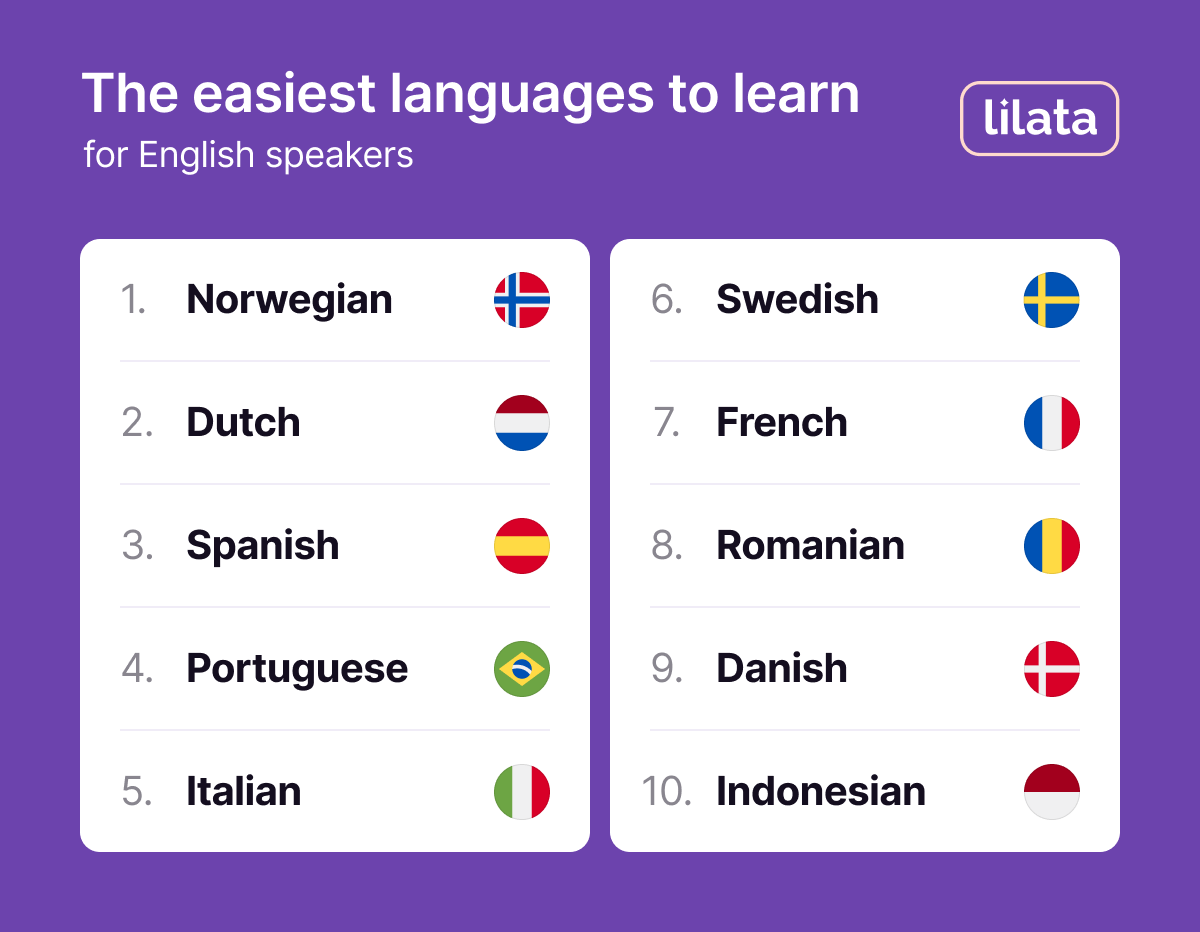

Learning any foreign language isn’t a walk in the park. However, some languages are easier to pick up because of shared roots, familiar vocabulary, or similar grammar. In this article, we’ll break down the easiest languages to learn for English speakers and look at why that’s the case.
Sidenote: Check out our overview of the hardest languages to learn.
Why are some languages easier to learn than others?
The main factor that determines how easy a language is to learn is its similarity to your native language. Generally speaking, the closer countries are geographically, the more similarities their languages share. Since English comes from (you guessed it) England, the languages of surrounding European countries influenced it.
English is a Germanic language, originating from the Germanic people who crossed the sea in ancient times and settled in England. These same people populated parts of Northern Europe, where other Germanic languages like Dutch and Norwegian developed. Because they share the same roots, they have similar vocabulary and grammar. For example, the Dutch word for water is “water”.
Another group closely related to English is the Romance languages. These are the languages that evolved from Latin, like Spanish, French, and Italian. Despite its Germanic roots, English borrowed heavily from Latin and French, particularly after the Norman Conquest of England and centuries of influence in education, religion, and culture. That’s why words like important in French and correcto in Spanish look so familiar.
Languages that use the Latin alphabet are also simpler to learn. You don’t have to memorize new symbols or writing systems. Additionally, in languages like Spanish or Italian, words are pronounced exactly as they’re spelled, making speaking much easier.
Finally, exposure and resources play a big role. A language you often hear, like Spanish or French, is easier and more rewarding to practice due to an abundance of speakers, movies, music, and books.
How easy are different languages to learn?
The Foreign Service Institute, an organization that teaches languages to U.S. diplomats, divides languages into 4 groups based on the time it takes to reach general professional proficiency.
1. Easiest languages
(24-30 weeks or 600-750 hours to achieve proficiency)
Norwegian, Dutch, Spanish, Portuguese, Italian, Swedish, French, Romanian, Danish.
2. Relatively easy languages
(36 weeks or 900 hours to achieve proficiency)
Indonesian, German, Malay, Swahili, Haitian Creole.
3. Hard languages
(44 weeks or 1100 hours to achieve proficiency)
Tagalog, Bengali, Hindi, Tamil, Farsi, Urdu, Turkish, Polish, Russian, Thai, Vietnamese etc.
4. Very hard languages
(88 weeks or 2200 hours to achieve proficiency)
Korean, Japanese, Arabic, Chinese.
The easiest languages for English speakers to learn
1. Norwegian

- Time to learn: 24 weeks (600 hours)
- Number of speakers: 5 million native and total speakers
- Countries: Norway
Norwegian is the easiest language to learn for English speakers. It shares Germanic roots with English, so its grammar and sentence structure feel very familiar. For example, the phrase “She likes music” translates to “Hun liker musikk.”
The vocabulary is also quite similar. For instance, “huset” means “the house” and “katt” means “cat.” Additionally, pronunciation in Norwegian is fairly simple and forgiving because there isn’t a single correct way to say words, regional variations are widely accepted.
2. Dutch

- Time to learn: 24 weeks (600 hours)
- Number of speakers: 24 million native, 28 million total speakers
- Countries: Netherlands, Belgium, Suriname
Dutch is the third most spoken Germanic language and one of the easiest languages to learn. It sits between English and German, sharing a significant amount of grammar and vocabulary. For example, the word “appel” means “apple,” and “boter” means “butter.” That said, Dutch grammar is significantly simpler than German.
Pronunciation can be tricky at first because some sounds, like the guttural g, don’t exist in English. Additionally, while many Dutch words are spelled the same as their English counterparts, they’re pronounced differently. For instance, “wind” is pronounced like “vint”.
3. Spanish

- Time to learn: 30 weeks (750 hours)
- Number of speakers: 486 million native, 560 million total speakers
- Countries: Mexico, United States, Colombia, Spain, Argentina, and others
Spanish is generally considered one of the easiest languages to learn for English speakers. Unlike English, it’s a Romance language, but its Latin roots create significant overlap with English vocabulary. For example, “familia” means “family,” and “importante” means “important.”
Spanish pronunciation is straightforward because it’s a phonetic language — words are pronounced the way they’re spelled. Once you learn the sounds of the alphabet, reading and speaking become fairly easy. The grammar is a bit more complex, with verb conjugations and gendered nouns, but it follows predictable patterns.
One of the biggest advantages of learning Spanish is its global reach — it’s the second most spoken language in the world by native speakers. Surprisingly, the United States is the second-largest Spanish-speaking country. You’ll find plenty of native speakers to practice with, along with Spanish movies, TV shows, books, and music to help you improve.
4. Portuguese

- Time to learn: 24 weeks (600 hours)
- Number of speakers: 236 million native, 264 million total speakers
- Countries: Brazil, Portugal, Angola, Mozambique
Portuguese is one of the most spoken languages in the world and it’s another Romance language on this list. This means many words come from Latin and are similar to English. For instance, “nacional” means “national,” and “universidade” means “university.”
Pronunciation in Portuguese is more challenging than in Spanish, particularly the nasal sounds. However, once you learn the basic patterns, words are mostly pronounced as they’re spelled.
An interesting aspect of Portuguese is its two major varieties: European Portuguese and Brazilian Portuguese. While they share grammar and most vocabulary, Brazilian Portuguese has a softer pronunciation and is often easier for learners. Be careful, though — some words can have very different meanings between the two.
5. Italian

- Time to learn: 24 weeks (600 hours)
- Number of speakers: 64 million native, 67 million total speakers
- Countries: Italy, Switzerland
Italian, just like Spanish and Portuguese, has Latin roots, so many words are easy to understand for English speakers. You’re likely already familiar with Italian words like pasta, opera, ciao, fiasco, which are part of everyday vocabulary in many countries.
Italian pronunciation is straightforward because it’s a phonetic language — words are pronounced as they’re spelled. The grammar, while involving verb conjugations and gendered nouns, follows clear and predictable rules.
Italian has a smaller reach than Spanish and Portuguese, as it is primarily spoken in Italy and a few neighboring countries, but its cultural influence remains significant worldwide.
6. Swedish

- Time to learn: 24 weeks (600 hours)
- Number of speakers: 10 million native, 13 million total speakers
- Countries: Sweden, Finland
As a fellow Germanic language, Swedish shares many similarities with English, including word order and vocabulary. For example, “bok” means “book,” and “salt” means, well, “salt.”
The grammar in Swedish is relatively simple, with no noun genders to worry about (except common and neuter) and simple verb conjugations. Pronunciation is also manageable, although mastering its musical tone patterns might take some practice.
With global brands like IKEA, Swedish words and culture have already seeped into everyday life. Many learners find themselves recognizing words like “smörgås” (sandwich) and “kök” (kitchen) just by assembling furniture!
7. French

- Time to learn: 30 weeks (750 hours)
- Number of speakers: 74 million native, 312 million total speakers
- Countries: France, Canada, Belgium, Switzerland, many African nations
French is a relatively easy language to learn for English speakers, thanks to the significant overlap in vocabulary. Centuries of shared history between England and France mean you won’t need a translator to understand French words like important, délicat, information, table, nation, and many others.
French pronunciation can be tricky at first, with silent letters and nasal sounds. Grammar also presents challenges, like gendered nouns and conjugations, but it follows predictable patterns that become easier with practice.
As the sixth most spoken language in the world and an official language in 29 countries, French is truly global. Whether you’re interested in international diplomacy, travel, or simply enjoying French literature and cinema, learning this language opens up many opportunities.
If you’re interested in learning French, check out these articles on the best methods, apps, and courses to help you get started.
8. Romanian

- Time to learn: 24 weeks (600 hours)
- Number of speakers: 19 million native, 24 million total speakers
- Countries: Romania, Moldova
Romanian, though less known, is another Romance language that is relatively easy to learn. Its Latin roots make many words recognizable, such as: familie, natural, student, doctor, important.
Words in Romanian are pronounced as they’re spelled, which simplifies speaking and reading. The grammar has some challenges, like noun cases and gendered nouns, but these follow patterns similar to other Romance languages.
Learning Romanian offers insight into a unique blend of Latin and Slavic ingredients, making it distinct from Spanish, French, or Italian.
9. Danish

- Time to learn: 24 weeks (600 hours)
- Number of speakers: 6 million native and total speakers
- Countries: Denmark
Danish is a North Germanic language closely related to Norwegian and Swedish, which makes it a good entry point to understanding these Scandinavian languages. Its grammar is straightforward and fairly close to English, with no noun cases and only two genders (common and neuter.)
Danish vocabulary shares many similarities with English. Here are a few words you might find familiar: kat, familie, telefon, elefant. However, pronunciation is where Danish becomes much more challenging. Words are often not pronounced as they’re spelled, and its unique glottal stop, known as stød, can take time to master.
10. Indonesian

- Time to learn: 36 weeks (900 hours)
- Number of speakers: 44 million native, 199 million total speakers
- Countries: Indonesia
Indonesian, or Bahasa Indonesia, stands out as one of the easiest Asian languages. It uses the Latin alphabet, so there’s no need to learn a new script. Indonesian vocabulary includes many loanwords from English and Dutch, like “universitas” and “televisi.” The language is also phonetic, meaning words are pronounced exactly as they’re spelled.
Grammar in Indonesian is extremely simple. There are no verb conjugations, tenses are indicated with time markers like “sudah” (already) or “akan” (will), and nouns don’t have plural forms — the word is just repeated twice, as in “buku-buku” (books). The sentence structure differs from English, but it follows logical patterns that are easy to pick up.
The data on speaker numbers and countries comes from the Ethnologue 2024 report.
Infographic




